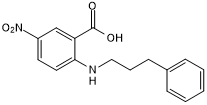
NPPB is a inhibits calcium-sensitive chloride currents (10 μM). Putative GPR35 agonist.

Acta Med Okayama. 2022 Aug;76(4):415-421.
5-Nitro-2-(3-phenylpropylamino) Benzoic Acid Inhibits the Proliferation and Migration of Lens Epithelial Cells by Blocking CaMKII Signaling
NPPB purchased from AbMole

Int J Mol Med. 2021 Apr;47(4):59.
5‑Nitro‑2‑(3‑phenylpropylamino) benzoic acid induces apoptosis of human lens epithelial cells via reactive oxygen species and endoplasmic reticulum stress through the mitochondrial apoptosis pathway
NPPB purchased from AbMole
| Molecular Weight | 300.31 |
| Formula | C16H16N2O4 |
| CAS Number | 107254-86-4 |
| Solubility (25°C) | DMSO ≥ 25 mg/mL |
| Storage |
Powder -20°C 3 years ; 4°C 2 years In solvent -80°C 6 months ; -20°C 1 month |
| Species | Mouse | Rat | Rabbit | Guinea pig | Hamster | Dog |
| Weight (kg) | 0.02 | 0.15 | 1.8 | 0.4 | 0.08 | 10 |
| Body Surface Area (m2) | 0.007 | 0.025 | 0.15 | 0.05 | 0.02 | 0.5 |
| Km factor | 3 | 6 | 12 | 8 | 5 | 20 |
| Animal A (mg/kg) = Animal B (mg/kg) multiplied by | Animal B Km |
| Animal A Km |
For example, to modify the dose of Compound A used for a mouse (20 mg/kg) to a dose based on the BSA for a rat, multiply 20 mg/kg by the Km factor for a mouse and then divide by the Km factor for a rat. This calculation results in a rat equivalent dose for Compound A of 10 mg/kg.
| Related Chloride Channel Products |
|---|
| NMD670
NMD670 is a first-in-class small molecule inhibitor of the skeletal muscle specific chloride ion channel (ClC-1). NMD670 improves skeletal muscle function in rat models with myasthenia gravis. |
| GaTx2
GaTx2 is a seletive and a high affinity inhibitor of ClC-2 channels with a voltage-dependent apparent KD of ∼20 pM. |
| Anthracene-9-carboxylic acid
Anthracene-9-carboxylic acid (9-Anthracenecarboxylic acid) is an anthracene derivative traditionally used to block and identify Ca2+-activated Cl- currents (CaCCs) in various cell types, like diverse smooth muscle cells, epithelial cells and salivary gland cells. |
| T16A(inh)-C01
T16A(inh)-C01 is an inhibitor of TMEM16A (ANO1). T16A(inh)-C01 blocks chloride channel mediated by ANO1 with an IC50 of 8.4 μM, without interfering with calcium signaling. |
| Picrotoxinin
Picrotoxinin, a potent convulsant, is a chloride channel blocker. Picrotoxinin is a noncompetitive GABAA receptor antagonist, which negatively modulates the action of GABA on GABAA receptors. |


Products are for research use only. Not for human use. We do not sell to patients.
© Copyright 2010-2023 AbMole BioScience. All Rights Reserved.
